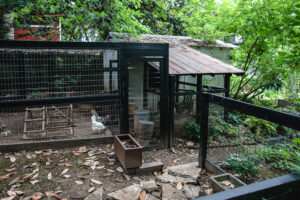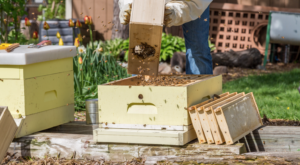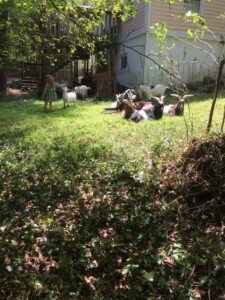Integrating livestock into your permaculture garden can enhance soil health, provide natural fertilization, and create a balanced, resilient system. Permaculture asks us to find balance not only in our landscapes but in our lives – livestock is a way to bridge the two, enhancing a closed-loop system that you, your family, and your new animals are a part of.
Benefits of Integrating Livestock
- Natural Fertilization: Livestock manure is rich in nutrients that can improve soil fertility. Chickens, rabbits, goats, and other animals produce waste that, when composted properly, can enrich your garden beds and boost plant growth.
- Pest Control: Animals such as ducks and chickens can help control insect populations. Chickens love to eat insects, slugs, and other pests that can damage your crops. Have you ever seen a chicken eat a mosquito? It’s the sweetest thing you’ll ever see. This reduces the need for chemical pesticides, promoting a healthier ecosystem.
- Soil Aeration and Tilling: Pigs and chickens can naturally till the soil, breaking up compacted ground and mixing organic matter into the soil. This helps prepare the land for planting and promotes healthy root development.
- Waste Reduction: Livestock can consume food scraps and garden waste, turning potential waste into valuable resources like manure and eggs. This helps create a closed-loop system where everything has a purpose and nothing is wasted.
- Diversity and Resilience: A permaculture garden that includes livestock is more diverse and resilient. The interactions between plants and animals create a balanced ecosystem that can better withstand pests, diseases, and extreme weather conditions.
Choosing the Right Livestock
When selecting animals for your permaculture garden, consider the following factors:
- Size of Your Land: The amount of space you have will determine the type and number of animals you can comfortably keep. Small gardens might be suitable for chickens, rabbits, or bees, while larger areas can accommodate goats, sheep, or pigs.
- Local Climate and Environment: Choose animals that are well-suited to your local climate and environment. This will ensure they thrive and require less intervention and resources to maintain their health and well-being.
- Your Needs and Goals: Consider what you hope to achieve by integrating livestock. If you want fresh eggs, chickens are a great choice. For milk, goats or cows might be more appropriate. Define your goals and choose animals that align with them.
Integrating Livestock into Your Garden
- Design with Zones: In permaculture, the concept of zones helps organize the garden based on the frequency of use and maintenance. Place animal enclosures in Zone 1 or Zone 2, where you can easily access and care for them daily.
- Rotational Grazing: Practice rotational grazing to prevent overgrazing and soil degradation. Move animals to different sections of your garden to allow the land to recover and regenerate. This also helps control parasites and promotes healthier pastures.
- Provide Shelter and Water: Ensure your livestock has adequate shelter and access to clean water. This is crucial for their health and well-being. Design shelters that protect animals from extreme weather conditions and predators.
- Incorporate Companion Planting: Use companion planting to create a symbiotic relationship between your plants and animals. For example, plant insect-repelling herbs near animal enclosures to reduce pests, or grow nitrogen-fixing plants to enhance soil fertility.
- Compost Manure: Properly compost animal manure before applying it to your garden. This process kills harmful pathogens and converts the manure into a nutrient-rich soil amendment. Use a dedicated composting area or integrate composting bins into your garden design.
Integrating livestock into your permaculture garden is a powerful way to enhance sustainability, improve soil health, and create a self-sufficient ecosystem. By carefully selecting the right animals and designing your garden with their needs in mind, you can enjoy the many benefits that livestock bring to a permaculture system. You’ll find that these animals will teach you so much about your landscape and will, no doubt, bring joy to your lives. Embrace the natural cycles and relationships between plants and animals, and watch your garden thrive.






